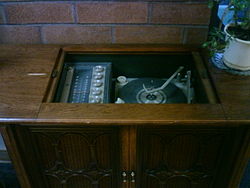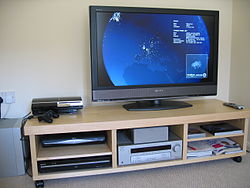- Entertainment center
-
For amusement centers, see Game center.
A home entertainment center (or stereo console) is a piece of furniture seen in many homes in North America, which houses major electronic items, such as a television set, a VCR and/or DVD player, stereo components (such as an AM/FM tuner, multi-disc Compact Disc changer, record player, one or more cassette players and graphic equalizer), and cable or satellite television receivers. A stereo console would contain components built into a cabinet, as was popular in the 1960s. These would be replaced by high-fidelity component stereos by the 1970s which offered much higher performance without being attached to furniture, or being tied to one brand of equipment.
Entertainment centers may be attached to high-fidelity stereo or quadraphonic speakers. By the 2000s, the best sound systems were designed for home theater and movie sound. It typically includes more than just the left and right stereo channels. Television and VHS typically encodes extra channels onto the two main channels, while digital modes encode this information into the digital DVD source data, with center, two rear, and a subwoofer speakers. The difficulty is usually in wiring and placing the rear speakers and the necessity of buying a receiver which can decode the sound. As the size of video monitors has increased, rather than having a 20 inch TV surrounded by massive stereo equipment, it is common to have a very large flat or projection screen with a small and integrated DVD player / receiver and satellite or digital cable receiver underneath, with small remote speakers and a moderate sized subwoofer.
The audio and video components have special connectors which are often hooked to a dedicated box whose connections and functions are known to only one person in the household. The items are then plugged into an electrical outlet strip, which should have a surge protector. Each component typically has its own remote control, though expensive universal remote controls are available that can learn or are programmed with most common equipment.
The term home entertainment center may also refer to the complete package – the electronic components and the unit in which they are housed. The unit is often either an armoire or a self-contained unit (usually of wood and glass); they often contain dedicated areas (either drawers or other spaces) for storage of records, videotapes, CDs and/or DVDs.
In many homes, an entertainment center is often placed in the living room, family room or recreation room. Perhaps the first example of a built-in entertainment center was created by Frank Lloyd Wright at his 1917 Hollyhock House in Los Angeles, California. Custom cabinetry and speakers may be built into or added to an existing house at some expense over free-standing furniture, and video and / or audio signals wired or wirelessly sent to other rooms in the home by dedicated cables, or over a local area network.
The term home entertainment center was widely used in the 1980s. It is being replaced by home theater system for large rooms. While high fidelity previously required large turntables, tape decks and speakers, the changing technology of music formats have made small bookshelf systems, Bose desktop radios, and iPod based speaker systems which can also produce music of high quality and serve as music entertainment systems, making large component systems again a niche high-end market.
See also
Categories:
Wikimedia Foundation. 2010.


